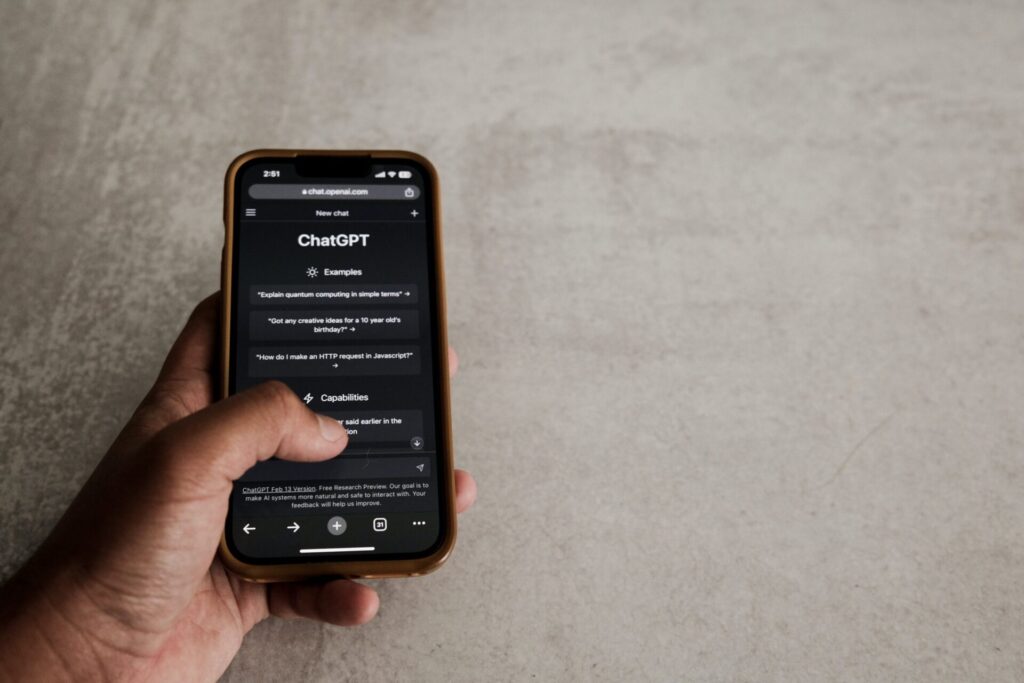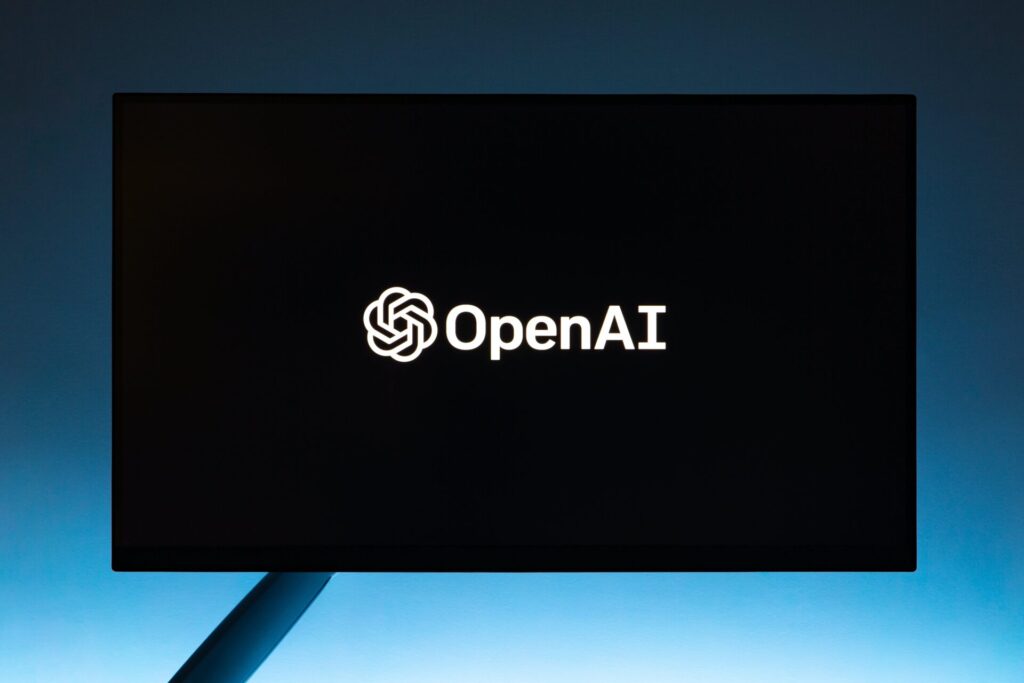Artificial intelligence has been a hot topic as of late, and I have been asking myself the question: how can therapists use AI? Can it be a helpful tool in my therapy practice?

Personally, my default reaction toward new technology tends to be fear. And that’s definitely been the case for me when it comes to AI. I’ve avoided it like the plague.
I have not touched ChatGBT or any other AI tools at all. Because it freaks me out!
But I have binge-watched a bunch of YouTube videos that demonstrate how people have used it for a huge assortment of tasks. From scripting YouTube videos to helping outline a blog post, to helping structure a week to be more productive. It seems as though it can do almost anything!
So for me, it’s time. It seems as though AI is here to stay. So I’m going to check out ChatGPT and see how therapists can use AI.
What’s ChatGPT?
If you are unfamiliar with ChatGPT, it’s like you are chatting with a person except it is an AI bot. You communicate in the form of written “conversation” back and forth. As you chat you keep providing more prompts to try to generate the information you need.

Asking ChatGPT To Help Me As A Therapist
First, I logged onto ChatGPT and set up a free account. Once my account was set up, a pop-up window came up to inform me that they were gathering external feedback through this free version of ChatGPT. So I don’t want to share anything that I wouldn’t want to share with other people.
It also gave the warning that sometimes it may generate incorrect information. It is good to remember that we shouldn’t trust the results 100% of the time.
I wanted to see if ChatGPT could help therapists. To do so, I wrote out a few prompts that I preplanned to type into the message box.
Can AI Help Support My Therapy Work?
The first prompt I typed into ChatGPT was: I’m a psychologist seeing therapy clients who identify as Christian and LGBTQ. List 5 ways you (chatgpt) can support the work that I do.
The result was amazing! I will summarize what the response was, but if you want to see the full chat response, I have it linked here.
The 5 ways that the AI bot stated it could help my therapy work included: educational resources, assisting with affirming language, exploring intersectionality, offering coping strategies, and helping with formulating interventions.
I was impressed with the idea of assisting with affirming language. That wasn’t even something I had thought of!
I was also blown away that it came up with the word: intersectionality. How does it even know that word?! It is one of my favorite words! And it is the best single word to summarize my specialty.
All five supports seemed very relevant and useful to the work that I do. I also appreciated the disclaimer that it gave at the end that it wouldn’t do the therapy work for me. But, it can be a helpful assistant.
If I wanted, I could’ve asked ChatGPT to list another 5 ways to assist me in expanding the list. I would have taken that step if the results weren’t exactly what I was looking for. But, I felt like the first 5 ideas were spot on.
What More Can ChatGPT Tell Me?

Instead, I decided to ask it to expand more on the third idea, which was the one about intersectionality. I typed in: “How can you help me explore intersectionality? List 5 ways.”
As the new list filled the screen, I couldn’t help but be wowed and amazed by how on-point the response was.
Of the 5 ideas it gave, there was one that I wanted to dig deeper into. It stated that it could help me identify support networks for my clients. I typed a new prompt asking ChatGPT to share what support networks it would recommend in San Diego County. (This is where I am located.)
I have been thinking about how I want to have a resource page on my therapy practice website, and AI was able to help me create a list that I could research. Before putting the resources ChatGPT gave me on my page, I would want to take time to look into them further. But it gave me a great place to start!
This first example of using ChatGPT shows how therapists could use AI within their specialties.
Can AI Help Therapists With Marketing?
But now, let’s pivot to a different topic.
The next prompt I had planned to ask ChatGPT was: “I’m a psychologist teaching fellow therapists about private practice on YouTube. List 5 areas the therapists I teach could benefit from using ChatGBT to market their private practices.”
So this time, I am interested to see if AI can help therapists with marketing their practices.
If you would like to read the full response to this prompt, I have it linked here.
The first idea that popped up was that ChatGPT could help with content creation. That was an idea I had already been thinking of. A lot of us are aware that this is something that AI can be useful for.
Other ideas for support included: FAQ support, social media engagement, email marketing, and incorporating ChatGPT in a website chatbox.
I feel like I could explore this topic a lot further, but I would encourage you to utilize ChatGPT if you are hoping for more support in marketing your practice. Try to give it as many specifics as you can.
I imagine that if you copied and pasted your “About Me” page and asked for marketing help specifically related to your specialties, it would be able to generate some helpful ideas.
Can AI Help With SEO?
I had heard that ChatGPT is supposed to be able to help with SEO. Game changer! If you are not familiar with SEO, I have lots of videos and blog posts about it.
My third planned prompt was: “I’m a psychologist who counsels people who identify as Christian and LGBTQ. Write 10 blog post titles that would benefit this population. Use SEO keywords in the titles.”
Some of the blog post titles that came up included: “Navigating the Intersection: Christian and LGBTQ Identity – A Guide to Self-Acceptance” and “Reconciling Faith and Orientation: Finding Peace as a Christian and LGBTQ Individual“.
These were some awesome blog post titles! I could’ve run off and written the blog posts that go with those titles right then. But, I wanted to take it a little further.
This time I threw a bunch of instructions at ChatGPT because I wanted to see if it could handle it.
I asked the AI bot to take the first blog title and write an outline for that blog. I wanted the blog to have 5 tools to help LGTBQ Christians navigate the intersection using evidence-based tools. And finally, I requested that the blog be written in the voice of Dr. Marie Fang.
After seeing what it came up with, I felt I couldn’t have come up with a better outline myself. I loved all the tips that were included.
Can ChatGPT Write A Blog Post?
There was one of the subsections that sounded the most “human”. That was about encouraging my reader to develop their own spiritual practice that aligns with their identity and beliefs. I decided to ask ChatGPT to write just that section of the blog post.
I found that the content that was generated included a lot of helpful tools that I would share myself. But, the writing did sound a lot more formal than my usual style. I then typed the prompt: “Rewrite it to be less formal and more chatty.”
The new blog post entry was definitely less formal, and now it was too casual. It included phrases like, “Hey there!” which I wouldn’t normally use.
This exercise demonstrates that you can ask ChatGPT to keep fine-tuning things. If there is something that you don’t like, you can request a change. The more specific you are in the feedback you give, the better it will accommodate you.
Be Aware of Watermarks
It is worth noting that there is some sort of “watermark” in any text that is developed by ChatGPT.
For example, if you were to have ChatGPT write an entire blog post that you then copied and pasted onto your website, it would get dinged in the Google algorithm as far as SEO. Google is going to sniff out that it was written by ChatGPT.
So it’s important to make sure you are taking whatever ChatGPT is giving you and making it yours. Hopefully, you can then bypass the watermark.
I did find a website that you can submit your text to, and they will tell you which parts are flagged as looking like AI-written text.
That’s Just Scratching The Surface!

I am sure there is way more functionality that ChatGPT has than this because I’m an absolute newbie. This is just the beginning of how therapists can use AI.
Part of why I wanted to try ChatGPT with a clean slate without having experimented with it before is because I wanted to make it feel less overwhelming for you. Just like I did, you can log in and check it out for yourself.
I’ve heard that the best way to learn about ChatGPT is to just start interacting with it, and see what it can do. Log in and experiment away!
I hope this article inspired you to try it out and see what happens!
AI Raises A Lot Of Questions
Before I close, I want to acknowledge that there are all kinds of ethical and other concerns surrounding AI. I’m not going to touch on those in this article, because that could be a whole other article in and of itself.
But, if you are interested in exploring these questions more, I want to recommend a podcast called “Skills AI Can’t Steal”. The host has conversations with different folks about how we can both leverage AI to our benefit and acknowledge the things that make us uniquely human.
And until next time, from one therapist to another: I wish you well!
-Marie
Photo by Steve Johnson on Unsplash
Image by Andrew Neel on Pexels
Photo by Airam Dato-on on Pexels
Photo by Andrew Neel on Pexels
Leave A Reply